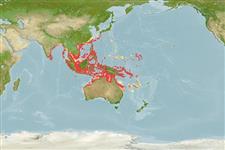分类 / Names
俗名 | 同种异名 | Catalog of Fishes(属, 种) | ITIS | CoL | WoRMS | Cloffa
Teleostei >
Eupercaria/misc (Various families in series Eupercaria) >
Caesionidae (Fusiliers) > Caesioninae
Etymology: Caesio: Latin, caesius, bluish-grey, 1835; it is the same name given to the silvery metal (Cs) (Ref. 45335).
More on author: Bloch.
Environment: milieu / climate zone / depth range / distribution range
生态学
海洋 礁区鱼类; 非迁移的; 深度上下限 1 - 60 m (Ref. 86942). 熱帶; 31°N - 28°S, 76°E - 172°E (Ref. 402)
Indo-West Pacific: Sri Lanka to Vanuatu; southern Japan to northern Australia.
印度-西太平洋: 斯里蘭卡到萬那度; 日本南部到澳洲北部。
大小 / 重量 / 年龄
Maturity: Lm ? range ? - ? cm
Max length : 60.0 cm TL 雄鱼/尚未辨别雌雄; (Ref. 402)
背棘 (总数) : 10; 背的软条 (总数) : 14 - 16; 臀棘: 3; 臀鳍软条: 10 - 12. Deep-bodied (Ref. 48636). Scales center lighter than margins; lower 1/3 white, sometimes suffused by pink; prominent black markings on caudal fin absent. 4-5 scales on cheek; predorsal scales 20-26; scaled dorsal and anal fins. Upper peduncular scale rows 9-11; lower peduncular scale rows usually 12-14. Distinguished from C. teres in having a continuous supra-temporal band of scales across the dorsal midline. Basioccipital process for attachment of Baudelot's ligament absent. Post maxillary process single; posterior end of maxilla blunt. Color: Upper body if not yellow, grayish blue; lower sides and belly white or pinkish. Pectoral, pelvic and anal fins white to pink. Large yellow tail. Dorsal fin yellow posteriorly and grayish blue anteriorly. Length usually at 35 cm (Ref. 48636). Head length 2.8-3.6 in SL; body depth 3.0-4.2 in SL (Ref. 90102).
身体纵深.(参考文献 48636) 鳞片中心颜色淡的超过边缘; 低的 1/3 白色,有时充满了粉红色; 在尾鳍上的突出的黑色斑纹不存在。 在颊上的 4-5 鳞片; 前背的鳞片 20-26; 覆有鳞片的背鳍与臀鳍。 上柄的鳞片列 9-11; 下柄的鳞片列通常 12-14. 在上方在有一个方面与 C. teres 区分了连续-横过背部中线的鳞片的当时条纹。 对于 Baudelot 的结带的附着的基枕骨突起不存在。 后颚的突起单个; 颚骨的后端钝的。 颜色: 身体上半部如果不是黄色, 灰蓝色; 下侧与腹部白色或略带桃色的。 胸鳍,腹鳍与臀鳍白色到粉红色。 大的黄色尾部。 背鳍黄色在后部地与灰蓝色前面地。 长度通常在 35 公分.(参考文献 48636)
Often in silty areas with low visibility at 1-30 m depth (Ref. 90102). Inhabits coastal areas, usually over rocky and coral reefs. Forms schools in midwater and feeds on zooplankton. Oviparous, with numerous, small pelagic eggs (Ref. 402). Taken primarily by handline in Sri Lanka; caught mostly by fish traps in western Thailand and Malaysia; caught in trawls in the Gulf of Thailand; caught by a variety of methods including drive-in nets, fish traps and gill nets in Indonesia, the Philippines and Papua New Guinea. The most ancestral living caesionid species.
栖息于沿岸区域, 通常在岩石与珊瑚礁上面。 群游于中层水域并且吃浮游动物。 卵生的, 有很多的, 小型大洋性鱼类卵.(参考文献 402) 在斯里兰卡主要以手执的钓丝捕获了; 在泰国西部与马来西亚大部份被鱼笼捕捉; 在泰国湾在拖网捕获了; 被在印度尼西亚,菲律宾与巴布亚新几内亚包括围网,鱼笼与刺网的多种方法捕获了。 最原始的活 caesionid 种。
Life cycle and mating behavior
成熟度 | 繁殖 | 产卵场 | 卵 | 孕卵数 | 仔鱼
印度-西太平洋: 斯里蘭卡到萬那度; 日本南部到澳洲北部。
Carpenter, K.E., 1987. Revision of the Indo-Pacific fish family Caesionidae (Lutjanoidea), with descriptions of five new species. Indo-Pac. Fish. (15):56 p. (Ref. 1723)
世界自然保护联盟红皮书 (Ref. 130435: Version 2024-1)
人类利用
渔业: 商业性
工具
特别资料
下载 XML
网络资源
Estimates based on models
Preferred temperature (Ref.
123201): 26.1 - 29.1, mean 28.3 °C (based on 1120 cells).
Phylogenetic diversity index (Ref.
82804): PD
50 = 0.5020 [Uniqueness, from 0.5 = low to 2.0 = high].
Bayesian length-weight: a=0.01622 (0.00944 - 0.02787), b=3.07 (2.92 - 3.22), in cm total length, based on LWR estimates for this species & (Sub)family-body (Ref.
93245).
营养阶层 (Ref.
69278): 3.4 ±0.45 se; based on food items.
回复力 (Ref.
120179): 中等的, 族群倍增时间最少 1.4 - 4.4年 (Preliminary K or Fecundity.).
Fishing Vulnerability (Ref.
59153): Moderate vulnerability (44 of 100).
Nutrients (Ref.
124155): Calcium = 40 [26, 56] mg/100g; Iron = 0.627 [0.417, 0.912] mg/100g; Protein = 19.1 [18.1, 20.0] %; Omega3 = 0.13 [0.09, 0.18] g/100g; Selenium = 37 [24, 62] μg/100g; VitaminA = 85.9 [35.4, 208.2] μg/100g; Zinc = 0.991 [0.741, 1.300] mg/100g (wet weight);
